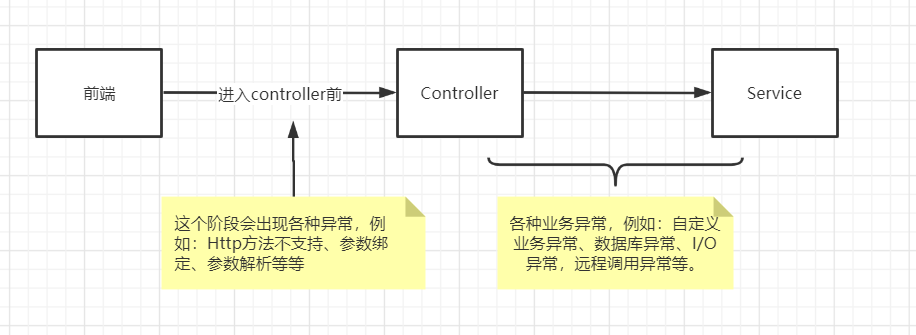统一异常处理
统一异常处理
让异常结果也显示为统一的返回结果对象,并且统一处理系统的异常信息,那么需要进行统一异常处理。
1、创建统一异常处理器
@Slf4j @Component //Spring容易自动管理 @RestControllerAdvice //在controller层添加通知。如果使用@ControllerAdvice,则方法上需要添加@ResponseBody public class UnifiedExceptionHandler { /** * 未定义异常 */ @ExceptionHandler(value = Exception.class) //当controller中抛出Exception,则捕获 public R handleException(Exception e) { log.error(e.getMessage(), e); return R.error(); } }
2、异常处理器要被Spring管理起来,需要设置被扫描进去
@SpringBootApplication @ComponentScan({"xx.xx.xx","xx.xx.UnifiedExceptionHandler所在包"}) public class 主启动类 {
3、处理特定异常
上诉返回的异常,就是实际的异常,一般不直接展示给界面用户,所以就需要个性化的显示异常信息,那么需要针对特定的异常做处理。
3.1 添加相应的异常类jar,本次对应的是jdbc依赖
<dependency>
<groupId>org.springframework</groupId>
<artifactId>spring-jdbc</artifactId>
</dependency>
3.2 添加相应的异常处理方法( UnifiedExceptionHandler 中)
/** * 特定异常 */ @ExceptionHandler(BadSqlGrammarException.class) public R handleBadSqlGrammarException(BadSqlGrammarException e){ log.error(e.getMessage(), e); return R.setResult(ResponseEnum.BAD_SQL_GRAMMAR_ERROR); }
问题:上面的例子虽然针对特定的异常显示个性化的错误信息,但是针对每个不同的异常我们都需要在项目中添加对应的处理方法,并捕获对应的异常对象,可能还要针对这个异常添加额外的依赖。这显然不是最好的方式。
优化方案:此类异常直接抛出,并且用Exception类捕获就可以了。
4、自定义异常
需求:使用一个或较少的异常类,可以捕获和显示所有的异常信息。
方案:因此,我们可以创建一个自定义异常类(必须是运行时异常),在程序中抛出这个自定义异常对象,并在统一异常处理器中捕获自定义异常对象。
4.1 创建自定义异常类
@Data @NoArgsConstructor public class BusinessException extends RuntimeException { //状态码 private Integer code; //错误消息 private String message; }
4.2 添加异常处理方法(UnifiedExceptionHandler类中)
/** * 自定义异常 */ @ExceptionHandler(BusinessException.class) public R handleBusinessException(BusinessException e){ log.error(e.getMessage(), e); return R.error().message(e.getMessage()).code(e.getCode()); }
4.3 修改Controller
添加异常处理,业务中需要的位置抛出BusinessException自定义异常。
@ApiOperation("新增积分等级")
@PostMapping("/save")
public R save(
@ApiParam(value = "积分等级对象", required = true)
@RequestBody IntegralGrade integralGrade){
//如果借款额度为空就手动抛出一个自定义的异常!
if(integralGrade.getBorrowAmount() == null){
//BORROW_AMOUNT_NULL_ERROR(-201, "借款额度不能为空"),
throw new BusinessException(ResponseEnum.BORROW_AMOUNT_NULL_ERROR);
}
boolean result = integrationService.save(integralGrade);
if (result) {
return R.ok().message("保存成功");
} else {
return R.error().message("保存失败");
}
}
五、异常优化处理
目标:以优雅的 Assert(断言) 方式来校验业务的异常情况,消除 if else
5.1 模仿org.springframework.util.Assert类,自定义Assert类
/** * 断言类:在程序运行的时候,帮助简化校验参数 * 为了适配枚举类,模仿org.springframework.util.Assert类,创建自定义Assert类 */ @Slf4j public abstract class Assert { /** * 断言对象不为空 * 如果对象obj为空,则抛出异常 * * @param obj 待判断对象 */ public static void notNull(Object obj, ResponseEnum responseEnum) { if (obj == null) { log.info("obj is null..............."); throw new BusinessException(responseEnum); } } }
5.2 修改controller,对应的位置替换成Assert
Assert.notNull(integralGrade.getBorrowAmount(),ResponseEnum.BORROW_AMOUNT_NULL_ERROR); // if(integralGrade.getBorrowAmount()==null){ // throw new BusinessException(ResponseEnum.BORROW_AMOUNT_NULL_ERROR); // }
六、Controller上层异常
6.1 异常分类

6.2 处理Controller上层异常
TODO:
posted on 2022-02-28 20:08 betterLearing 阅读(561) 评论(0) 编辑 收藏 举报





【推荐】国内首个AI IDE,深度理解中文开发场景,立即下载体验Trae
【推荐】编程新体验,更懂你的AI,立即体验豆包MarsCode编程助手
【推荐】抖音旗下AI助手豆包,你的智能百科全书,全免费不限次数
【推荐】轻量又高性能的 SSH 工具 IShell:AI 加持,快人一步
· TypeScript + Deepseek 打造卜卦网站:技术与玄学的结合
· 阿里巴巴 QwQ-32B真的超越了 DeepSeek R-1吗?
· 【译】Visual Studio 中新的强大生产力特性
· 10年+ .NET Coder 心语 ── 封装的思维:从隐藏、稳定开始理解其本质意义
· 【设计模式】告别冗长if-else语句:使用策略模式优化代码结构